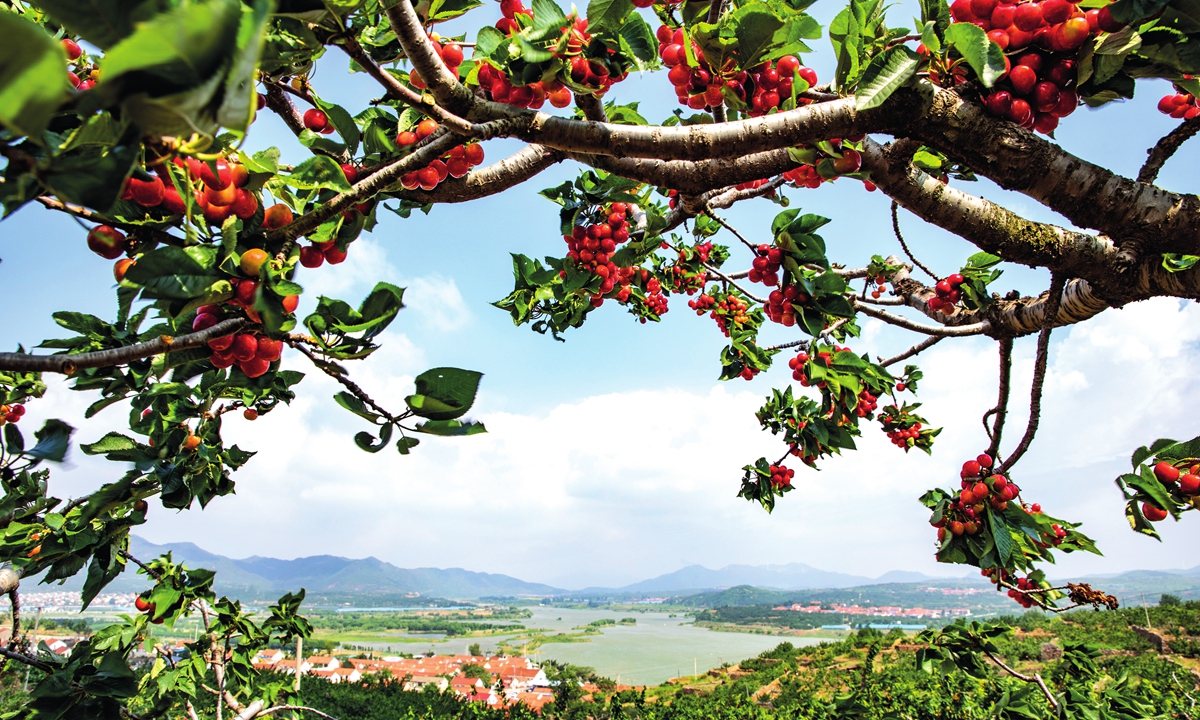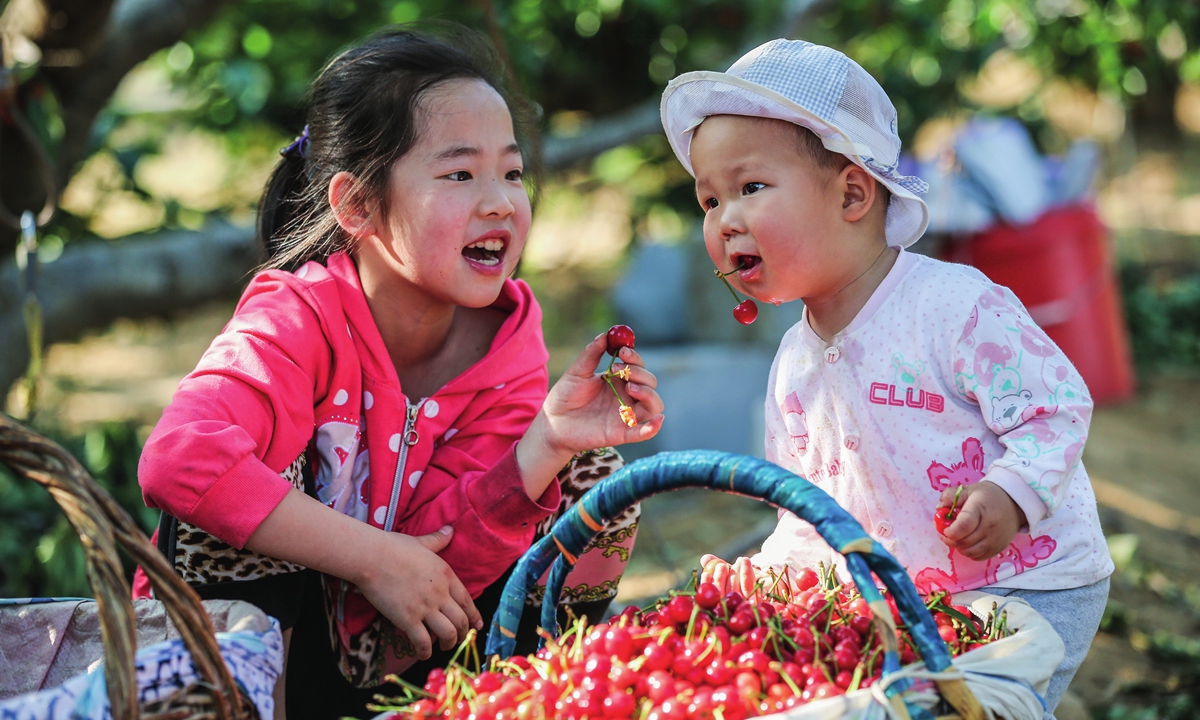Blossom of Zhanggezhuang cherries offers a snapshot of China’s rural revitalization


Cherries in Zhanggezhuang Photo: Courtesy of Zhanggezhuang government
Zhang Huichen, a cherry farmer in her 30s in Zhanggezhuang Township, East China's Shandong Province, is adjusting the temperature and humidity of a cherry greenhouse through her smartphone on Monday. With a press in the button, the aster cloth slowly scrolls down, shielding her cherry plants from the scorching midday sun.
Zhang owns about 10 cherry greenhouses, or equivalent to 30 mu (approximately 20 square kilometers) of cherry farmland, all of which have been installed using an intelligent control system that enable her to monitor the situation in real time, via a mobile app connected to the system.
"Cherry grown in the greenhouse generally matures in late April, and March is a critical period for flower pollination. That means we need to keep a close look over the environment so as to ensure both the maximum productivity and the best quality," Zhang told the Global Times in a recent interview.
Last year, Zhang quit her urban job and started a career with her family as cherry farmers. To date, she has invested about 2.1-- 2.4 million yuan in building greenhouses, upgrading cherry varieties and purchasing agricultural materials, betting on the strong sales figures for her homegrown cherry products. For this year's plan, Zhang plans to expand the greenhouses and strengthen cooperation with e-commerce platform such as Pinduoduo.
Zhang is just one among the 12,000 cherry farmers in Zhanggezhuang Township, a Chinese agricultural town in Yantai's Fushan district, which is called "China's first cherry town," which is on a rapid development thanks to the national rural revitalization strategy and government's focus on rural development.
The history of planting cherry at the town dates back to 1871, when the very first cherry variety was brought in by an American missionary. Now, about 90 percent of the 20,000-mu farmland at the town is planted with cherry, with an annual output of 30,000 kilograms. And as of the end of 2021, the planting area of Fushan district reached 110,000 mu, accounting for 20 percent of the national total.
The town's booming cherry industry, plus the increasing popularity of homegrown cherries among domestic consumers, has created a lucrative business chain that not only draws back younger people like Zhang who bring in more advanced agricultural technologies, but also elevates local farmers' incomes that contributes to China's rural revitalization.

Children enjoy cherries at a park in Zhanggezhuang. Photo: Courtesy of Zhanggezhuang government
'Making a difference'
"Almost every household in the town makes a living from planting cherries, earning 20,000 -- 30,000 yuan annually. Years of cherry farming have made a huge difference on local residents' living standards, for example our town has eradicated poverty many years ago," Yan Shunjie, director of Agricultural Integrated Service Center in Zhanggezhuang Township, told the Global Times.
He attributed the success of cherry farming in Zhanggezhuang to a number of natural advantages such as warmer weather, high-quality water and soil of rich minerals.
"In fact, the quality of homegrown cherries is no inferior to imported ones, like the renowned Chilean cherries. Some are even better due to the freshness, compared with imports that take months of shipments. China also has set up its own standards in classifying cherries, and we're carrying out the standard in a strict manner," Yan said.
Local farmers said that homegrown cherries have been gaining popularity in the Chinese markets over recent years, partly fueled by the penetration of online selling platforms, the development of cold-chain transportation that extends the preservation of cherries and the prevailing live-streaming platforms that allows cherry farmers and vendors to communicate with online consumers directly.
"Online sales currently account for 20 percent of market sales, which is expected to tick up this year as a number of e-commerce platform such as Taobao, Pinduoduo and Douyin has approached the local government for deeper cooperation," Yan said, while noting that online sales are estimated to elevate the revenues by at least 2,000 yuan per mu, which generally yield 1.5 kilograms cherries a year.
In 2014, the local government invested and set up a cherry trade exchange market to facilitate transactions between local farmers, dealers, and large buyers. To date, the investment has topped 50 million yuan, and most of the offline transactions are completed at the exchange platform.
Meanwhile, local farmers are exploring overseas markets in Japan and South Korea, which enjoy geographic proximity to Shandong Province that enables freshly picked cherries from Zhanggezhuang to be delivered to the two countries within days.
Last year, several tons of cherries were sent to Japan and South Korea for the first time, after being harvested and going through a pre-cooling process.
More promising plans
In Zhanggezhuang, growing cherry is a "periodic" farming practice that usually starts in February and last till June when cherries ripen and are shipped to market
Meanwhile, Chilean cherries, which account for roughly 90 percent of China's cherry imports, mature in the winter, and are available for sales in the Chinese market from November to January next year, often ahead of China's Spring Festival holidays.
Industry observers said that there's a difference between homegrown and Chilean cherries as to when they're sold, but the overlap is increasing as cherry greenhouse technology becomes more widely used in Zhanggezhuang, meaning that some of the cherry crop could be harvested as early as February.
"This year, we tried out selling a small number of homegrown cherries on the domestic market ahead of the Spring Festival. They sold at around 500 yuan per kilogram, and have proven to be quite popular. As such, we plan to amplify the 'earlier reap' planting next year," Yan said. In line with the plan, the local government in Zhanggezhuang has been steadily promoting greenhouse technology among local farmers.
Also, some villages under the jurisdiction of Zhanggezhuang are developing high value-added cherry byproducts, as part of the ongoing efforts to improve local farmers' income.
Che Shaobo, an official of Chejia Village in Zhanggezhuang, told the Global Times that the village has cooperated with a manufacturer in the city of Rizhao to produce cherry juice with a 12-month shelf-life, whose profit could double compared with selling cherry fruits and could be sold throughout a year.
"Last year, we sold 3,000 to 4,000 kilograms of cherry juice, and buyers are mostly high-end hotels, supermarkets and private clubs in Yantai. So we plan to open more sales channels in the first-tier cities like Beijing and Shanghai," Che said.
The village is also researching pillows made with cherry stones, a kind of healthcare product which Che said could help soothe the nerves.


